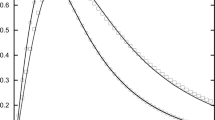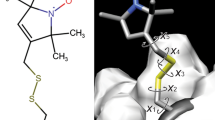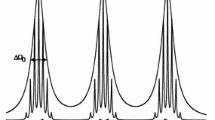Abstract
The Dobryakov–Lebedev relation (Sov Phys Doklady 13:873, 1969), which relates the line width of the first-derivative of a Gaussian–Lorentzian convolution to the line widths of its Gaussian and Lorentzian components for an unresolved EPR line, is extended to resolved lines. Applying this extension to nitroxide-free radicals in solutions of low-viscosity solvents offers an opportunity to study interactions of the spins with the microwave field and spin–spin interactions previously inaccessible except by tedious numerical methods.









Similar content being viewed by others
References
A.S. AlOmar, Optik 225, 165533–165544 (2021)
W. Voigt, Phys. Z. 14, 377 (1913)
B.H. Armstrong, J. Quant. Spect. Radiat. Transf. 7, 61–88 (1967)
B.L. Bales, in Biological Magnetic Resonance, vol. 8, ed. by L.J. Berliner, J. Reuben (Plenum, New York, 1989), pp. 77–130
H.J. Halpern, M. Peric, C. Yu, B.L. Bales, J. Magn. Reson. 103, 13–22 (1993)
G.K. Wertheim, M.A. Butler, K.W. West, D.N.E. Buchanan, Rev. Sci. 45, 1369–1371 (1974)
S. Lee, A. Shetty, J. Chem. Phys. 83, 499–505 (1985)
T.G. Castner Jr., Phys. Rev. 115, 1506–1515 (1959)
J. Zimbrick, L. Kevan, J. Chem. Phys. 47, 2364–2371 (1967)
L.J. Berliner, Spin labeling: the next millennium, in Biological magnetic resonance, vol. 14, ed. by L.J. Berliner (Kluwer Academic Publishers, New York, 2002), p. 444
L.J. Berliner, Spin Labeling: Theory and Applications (Plenum Publishing Corporation, New York, 1989)
L.J. Berliner, Spin Labeling II: Theory and Applications (Academic Press, New York, 1979)
D. Marsh, Spin-Label Electron Paramagnetic Resonance Spectroscopy (CRC Press. Taylor & Francis Group, Boca Raton, 2020)
C.P. Poole Jr., Electron Spin Resonance: A Comprehensive Treatise on Experimental Techniques, 2nd edn. (Dover, New York, 1996)
M.M. Bakirov, K.M. Salikhov, M. Peric, R.N. Schwartz, B.L. Bales, Appl. Magn. Reson. 50, 919–942 (2019)
B.L. Bales, M.M. Bakirov, R.T. Galeev, I.A. Kirilyuk, A.I. Kokorin, K.M. Salikhov, Appl. Magn. Reson. 48, 1399–1445 (2017)
B.L. Bales, M. Peric, M.T. Lamy-Freund, J. Magn. Reson. 132, 279–286 (1998)
J.S. Hyde, M. Pasenkiewicz-Gierula, A. Jesmanowicz, W.E. Antholine, Appl. Magn. Reson. 1, 483–496 (1990)
B.H. Robinson, C. Mailer, A.W. Reese, J. Magn. Reson. 138, 199–209 (1999)
S.N. Dobryakov, Y.S. Lebedev, Sov. Phys. Doklady 13, 873 (1969)
K.M. Salikhov, Fundamentals of Spin Exchange. Story of a Paradigm Shift (Springer, Cham, 2019)
P.L. Lee, Nucl. Instrum. Methods 144, 363–365 (1977)
G. Poggi, C.S. Johnson Jr., J. Magn. Res. 3, 436–445 (1970)
C. Jolicoeur, H.L. Friedman, Ber. Bunsenges. Phys. Chem. 75, 248–257 (1971)
K.M. More, G.R. Eaton, S.S. Eaton, J. Magn. Reson. 60, 54–65 (1984)
M.F. Ottaviani, J. Phys. Chem. 91, 779–784 (1987)
J.J. Windle, J. Magn. Reson. 45, 432–439 (1981)
P.R. Bevington, Data Reduction and Error Analysis for the Physical Sciences (McGraw-Hill, New York, 1969)
W.Z. Plachy, D.A. Windrem, J. Magn. Reson. 27, 237–239 (1977)
M.R. Kurban, M. Peric, B.L. Bales, J. Chem. Phys. 129, 064501-1-064501–10 (2008)
M. Peric, B.L. Bales, M. Peric, J. Phys. Chem. A 116, 2855–2866 (2012)
M.T. Jones, J. Chem. Phys. 38, 2892–2895 (1963)
K.M. Salikhov, Appl. Magn. Reson. 723, 1074–1087 (2018)
A.M. Portis, Phys. Rev. 91, 1071–1078 (1953)
M.P. Eastman, R.G. Kooser, M.R. Das, J.H. Freed, J. Chem. Phys. 51, 2690 (1969)
G.R. Eaton, S.S. Eaton, D.P. Barr, R.T. Weber, Quantitative EPR (Springer, New York, 2010)
J.M. Backer, V.G. Budker, S.I. Eremenko, Y.N. Molin, Biochim. Biophys. Acta 460, 152–156 (1977)
W.K. Subczynski, J.S. Hyde, Biophys. J. 41, 743–746 (1983)
H.J. Halpern, C. Yu, M. Peric, E. Barth, D.J. Grdina, B.A. Teicher, Proc. Natl. Acad. Sci. 91, 13047–13051 (1994)
R. Ahmad, P. Kuppusamy, Chem. Rev. 110, 3212–3236 (2010)
B.L. Bales, F.L. Harris, M. Peric, M. Peric, J. Phys. Chem A 113, 9295–9303 (2009)
B.L. Bales, M. Peric, I. Dragutan, J. Phys. Chem. A 107, 9086–9098 (2003)
B.L. Bales, M. Peric, J. Phys. Chem. A 106, 4846–4854 (2002)
B.L. Bales, M. Peric, J. Phys. Chem. B 101, 8707–8716 (1997)
B.L. Bales, D. Mareno, F.L. Harris, J. Magn. Reson. A 104, 37–53 (1993)
B.L. Bales, M. Meyer, S. Smith, M. Peric, J. Phys. Chem A 112, 2177–2181 (2008)
D. Merunka, M. Peric, J. Chem. Phys. 152, 024502–024508 (2020)
J. Labsky, J. Pilar, J. Lövy, J. Magn. Reson. 37, 515–522 (1980)
W. Plachy, D. Kivelson, J. Chem. Phys. 47, 3312 (1967)
Acknowledgements
Support from NSF through NSF MRI (Grant No. 1626632—B.L.B. and M.P) and NSF RUI (Grant No. 1856746—M.P.) is acknowledged. This work was supported by the Grant for the fundamental research of the Presidium of the Russian Academy of Sciences 1.26 Π.
Author information
Authors and Affiliations
Corresponding author
Additional information
Dedicated to Kev Salikhov and Klaus Möbius, the birthday brothers.
Publisher's Note
Springer Nature remains neutral with regard to jurisdictional claims in published maps and institutional affiliations.
Appendix: Criterion for Incipient Resolution
Appendix: Criterion for Incipient Resolution
The criterion for incipient resolution has always been subjective, defined as the value of \(\chi \) where a visual distortion of an IHB occurs. Before, we observed the peak of the line and decided if it was a normal smooth curve or not.
Figure 10 shows a series of simulated Tempol spectra at \(\chi \) = a 1.17, b 2.54, c 2.98, d 3.44, e 4.13, and f 5.29. The residuals are amplified as indicated; for example, in b, the residual has been amplified by a factor of 7.55. In our opinion, a practiced eye may discern incipient resolution in c at a glance, without any fitting. The insert shows the peak region in more detail. d with its insert shows a definite distortion that anyone may discern. This criterion is still subjective; however, once we decide, we may quantify it by specifying the ratio \({V}_{\mathrm{res}}/{V}_{\mathrm{pp}.}\) For c, \(\chi \) = 2.98, \({V}_{\mathrm{res}}/{V}_{\mathrm{pp}.}\) = 0.02. If it becomes important, one could subtract the broad resonances evident in Fig. 1c to be more precise because it is the narrow residual lines that yield the information.
Rights and permissions
About this article
Cite this article
Bakirov, M.M., Khairutdinov, I.T., Schwartz, R.N. et al. The Dobryakov–Lebedev Relation Extended to Partially Resolved EPR Spectra. Appl Magn Reson 53, 1151–1174 (2022). https://doi.org/10.1007/s00723-021-01433-z
Received:
Revised:
Accepted:
Published:
Issue Date:
DOI: https://doi.org/10.1007/s00723-021-01433-z





